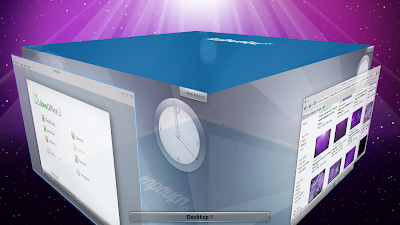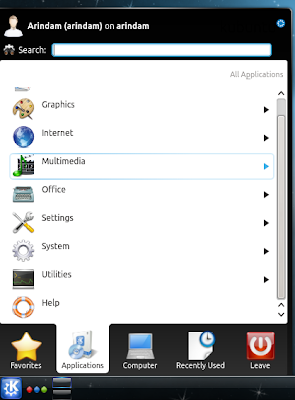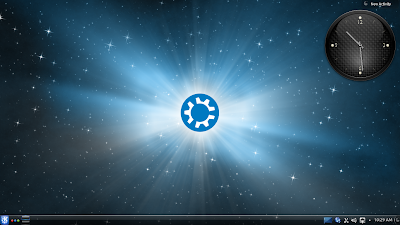Kubuntu 12.04 LTS received a new update a couple of weeks ago and I have been using it for last two weeks. I installed it on a partition in my Asus K54C laptop with Core i3 2.2 Ghz processor and 2 GB RAM. There is no separate graphic card option in this machine except Intel proprietary graphic card which came along with it.
The latest update came with some significant changes like drivers for the new Haswell processors, out of the box support for NVIDIA and AMD Raedon graphic cards, and a lot of bug fixes. However, unlike Ubuntu 12.04.3, updated Linux kernel 3.8.0 is not available to Kubuntu LTS yet - still running on LTS kernel 3.2.0. Unfortunately I don't have any laptop beyond Ivy Bridge and hence could check Kubuntu's latest update on systems with the most recent Haswell processors. Otherwise, in this write up I take you through my experience of Kubuntu for about 10 days.
Kubuntu 12.04.3 32-bit ISO is about 738 MB in size and I did a live boot followed by installation to my Asus K54C for this review. By default, it ships with KDE 4.8.5, which is still the stable release of KDE. It worked well but I decided to install KDE 4.11. My previous experience with KDE 4.11 in OS4 OpenLinux was really fantastic and I wanted to try it out in Kubuntu as well.
Installation
Kubuntu installation process is still the same and no surprises there. It asked for Language, geographic location, Keyboard type and language, location to install and finally, user ID details. Entire installation, including download of updates and third party multimedia codecs took me about 30 minutes of time. And it went smooth.
Aesthetics
Aesthetics is still the boring look with the grey colored default wallpaper. KDE 4.8.4 has by default Oxygen theme and looks decent but the Aria grey wallpaper kills it all. However, KDE is very customizable with loads of themes and other customization options. And that really helps in case of Kubuntu, to get rid of the boring look and make it more exciting.
Dolphin 2.0 is the default browser, as was the previous two upgrades. The usual sophistication of KDE plasma desktop is there in Kubuntu and it looks professional. though boring.
Anyway, the usual KDE goodies, namely animations, desktop cube, etc. are there and OpenGL worked without any issue. Desktop widgets like clock, weather, etc. are there to make the desktop environment look better.
The default KDE kickoff menu was a bit complex and inefficient for me though it looked good. So, I changed back to the simple menu which may not look as good but it works better for me.
Overall, Kubuntu's default interface looks professional but not exciting.
I must add here, that with KDE 4.11.00, I got a better user experience and aesthetics. The subtle sky blue shadow lines for open tabs, smoother transitions, more consistent and fluid behavior, less resource consumption, etc. - everything added to a wonderful experience. KDE 4.11. It is possibly the best KDE I have used.
Applications
Application list is similar to the last two updates and there is no LibreOffice 4.1 or GIMP 2.8 yet in the Precise repos, which is a let down. The main applications are listed below:
Otherwise, multimedia codecs and Adobe Flash plugin 11, gets downloaded during installation. Flash works well with Rekonq and I could my favorite YouTube and Dailymotion videos, post-installation.
I prefer using LibreOffice 4.* more than LibreOffice 3.5 as some of the functionalities that I require, are not there in the previous versions. So, I did installed LibreOffice 4.1 along with GIMP 2.8 by adding respective ppa's as mentioned in my write up on Ubuntu 12.04.3.
Upgrading to KDE 4.11
To upgrade, I first added the Kubuntu backport ppa, by running the following commands in the terminal:
sudo add-apt-repository ppa:kubuntu-ppa/backports
Once the ppa is added, I did an update and then installed the latest KDE by:
sudo apt-get update
sudo apt-get install plasma-mediacenter
sudo apt-get dist-upgrade
This actually upgraded all the KDE specific applications, including Dolphin. Most notable change in KDE 4.11 is that now KWin has moved to modern technology and graphic card support. OpenGL 3.1 support is now available in the latest KDE.
And post reboot, the shiny new KDE 4.11.00 with Dolphin 4.11.00 was my DE. It is much smoother to use and comes with better and advanced OpenGL support. I created my own customized theme (Window decoration: Plastik instead of Oxygen, Desktop theme: Glassified, and some other minor changes) and the end result looked stunning!
I feared a bit of instability because of KDE 4.11.00. However, everything went smooth and except system monitor, rest of the applications work as expected. System monitor threw a bit of error and won't show the CPU and RAM usage charts. Even LibreOffice 4.1 worked like a charm with KDE 4.11.
Repository
Kubuntu has Muon Software Center as the default GUI to access Ubuntu Precise repositories. It is perhaps the richest repo in the Linux world and has applications for every common requirement. Synaptic package manager is not there by default but can be installed from the repos. I didn't face any issue in downloading applications via Muon and though it is not as good as Ubuntu Software Center, but works decently.
Performance
I recorded Kubuntu's performance both with KDE 4.8.5 and KDE 4.11.00. From Kubuntu 12.04.1 to Kubuntu 12.04.3, performance has improved significantly. Kubuntu 12.04.3 actually performed better than Kubuntu 13.04 and took about 10% less RAM to boot the DE with system monitor running. With the addition of KDE 4.11.00, RAM usage under identical conditions dropped by 15% to 220 MB.
Numbers aside, Kubuntu 12.04.3 is really very smooth to use with subtle effects and animations. KDE 4.11.00 further enhanced the smoothness of use. I got impressive performance with stunning looks. I am using it for about 10 days with KDE 4.11.00 and using it as my main distro - didn't notice any instability till date.
If I compare Kubuntu 12.04.3 to other KDE distros, with KDE 4.11.00, it gives a mind blowing performance and even beats Mageia, the King of KDE distros. Of course, Mageia 3, I tested, didn't have KDE 4.11 that time and it will be interesting to compare with Mageia 4 Alpha 1 with KDE 4.11.
In the Kubuntu 12.04.3 installation, since both KDE 4.11 and KDE 4.8.5 are present, hence it took a bit of more space.
Overall
Kubuntu 12.04.3 is surely a very stable update and those who are using the Precise Pangolin release, I recommend them to continue using it. KDE 4.11.00 or not, the LTS release is still way better than Kubuntu 12.10 or 13.04.
To the first time users, Kubuntu 12.04.3 is wholeheartedly recommended! It is the best Kubuntu release out there, simple and intuitive to use. The Quantal and Raring releases don't add anything extra in terms of features and Kubuntu 12.04 is miles ahead in terms of efficiency. However, you may like to add the ppa's of the recent updates of some critical applications like LibreOffice, GIMP, etc.
Further, definitely you should upgrade to KDE 4.11. It is the best KDE I have used till date in terms of refinement and usability. It's support for modern hardware, too, is better than the previous KDE editions. And if you talk of performance, Kubuntu just gets better with KDE 4.11!
You can download the 32-bit and 64-bit versions of Kubuntu 12.04.3 from here.
The latest update came with some significant changes like drivers for the new Haswell processors, out of the box support for NVIDIA and AMD Raedon graphic cards, and a lot of bug fixes. However, unlike Ubuntu 12.04.3, updated Linux kernel 3.8.0 is not available to Kubuntu LTS yet - still running on LTS kernel 3.2.0. Unfortunately I don't have any laptop beyond Ivy Bridge and hence could check Kubuntu's latest update on systems with the most recent Haswell processors. Otherwise, in this write up I take you through my experience of Kubuntu for about 10 days.
 |
| From Kubuntu 12.04.3 http://mylinuxexplore.blogspot.in |
Installation
Kubuntu installation process is still the same and no surprises there. It asked for Language, geographic location, Keyboard type and language, location to install and finally, user ID details. Entire installation, including download of updates and third party multimedia codecs took me about 30 minutes of time. And it went smooth.
 |
| From Kubuntu 12.04.3 http://mylinuxexplore.blogspot.in |
Aesthetics is still the boring look with the grey colored default wallpaper. KDE 4.8.4 has by default Oxygen theme and looks decent but the Aria grey wallpaper kills it all. However, KDE is very customizable with loads of themes and other customization options. And that really helps in case of Kubuntu, to get rid of the boring look and make it more exciting.
 |
| From Kubuntu 12.04.3 http://mylinuxexplore.blogspot.in |
Dolphin 2.0 is the default browser, as was the previous two upgrades. The usual sophistication of KDE plasma desktop is there in Kubuntu and it looks professional. though boring.
Anyway, the usual KDE goodies, namely animations, desktop cube, etc. are there and OpenGL worked without any issue. Desktop widgets like clock, weather, etc. are there to make the desktop environment look better.
 |
| From Kubuntu 12.04.3 http://mylinuxexplore.blogspot.in |
 |
| Default Menu From Kubuntu 12.04.3 http://mylinuxexplore.blogspot.in |
 |
| Simple Menu From Kubuntu 12.04.3 http://mylinuxexplore.blogspot.in |
I must add here, that with KDE 4.11.00, I got a better user experience and aesthetics. The subtle sky blue shadow lines for open tabs, smoother transitions, more consistent and fluid behavior, less resource consumption, etc. - everything added to a wonderful experience. KDE 4.11. It is possibly the best KDE I have used.
 |
| Default KDE 4.11 interface From Kubuntu 12.04.3 http://mylinuxexplore.blogspot.in |
 |
| KDE 4.11 with Glassified theme From Kubuntu 12.04.3 http://mylinuxexplore.blogspot.in |
Application list is similar to the last two updates and there is no LibreOffice 4.1 or GIMP 2.8 yet in the Precise repos, which is a let down. The main applications are listed below:
- Office: LibreOffice 3.5.7.2 suite – Writer, Calc, Impress, Draw, Math, KAddressbook, Okular, Kontact, Korganizer, KTimeTracker
- Internet: Ktorrent, BlueDevil, Akregator, Kopete IM, KPPP, Quaseel IRC, KMail, Mozilla Firefox Installer, Rekonq browser
- Graphics: Gwenview image viewer, Ksnapshot
- Multimedia: Amarok music player, K3b, Dragon video player
- Accessories: Kate text editor, Ark archiving tool, Klipper, Knotes, Kcalc, KMag, Synaptiks, Kvkbd, Nepomuk backup, Nepomuk file indexing controller, Konsole, KDE Wallet, Startup disk creator
Otherwise, multimedia codecs and Adobe Flash plugin 11, gets downloaded during installation. Flash works well with Rekonq and I could my favorite YouTube and Dailymotion videos, post-installation.
 |
| YouTube on Rekonq From Kubuntu 12.04.3 http://mylinuxexplore.blogspot.in |
Upgrading to KDE 4.11
To upgrade, I first added the Kubuntu backport ppa, by running the following commands in the terminal:
sudo add-apt-repository ppa:kubuntu-ppa/backports
Once the ppa is added, I did an update and then installed the latest KDE by:
sudo apt-get update
sudo apt-get install plasma-mediacenter
sudo apt-get dist-upgrade
This actually upgraded all the KDE specific applications, including Dolphin. Most notable change in KDE 4.11 is that now KWin has moved to modern technology and graphic card support. OpenGL 3.1 support is now available in the latest KDE.
And post reboot, the shiny new KDE 4.11.00 with Dolphin 4.11.00 was my DE. It is much smoother to use and comes with better and advanced OpenGL support. I created my own customized theme (Window decoration: Plastik instead of Oxygen, Desktop theme: Glassified, and some other minor changes) and the end result looked stunning!
 |
| Glassified theme From Kubuntu 12.04.3 http://mylinuxexplore.blogspot.in |
 |
| Oxygen theme From Kubuntu 12.04.3 http://mylinuxexplore.blogspot.in |
Repository
Kubuntu has Muon Software Center as the default GUI to access Ubuntu Precise repositories. It is perhaps the richest repo in the Linux world and has applications for every common requirement. Synaptic package manager is not there by default but can be installed from the repos. I didn't face any issue in downloading applications via Muon and though it is not as good as Ubuntu Software Center, but works decently.
 |
| Muon Software Center From Kubuntu 12.04.3 http://mylinuxexplore.blogspot.in |
I recorded Kubuntu's performance both with KDE 4.8.5 and KDE 4.11.00. From Kubuntu 12.04.1 to Kubuntu 12.04.3, performance has improved significantly. Kubuntu 12.04.3 actually performed better than Kubuntu 13.04 and took about 10% less RAM to boot the DE with system monitor running. With the addition of KDE 4.11.00, RAM usage under identical conditions dropped by 15% to 220 MB.
| Operating System | Size of ISO | Base | Desktop | Linux kernel | CPU Usage | RAM usage | Size of installation |
| Kubuntu 12.04.3 LTS with KDE 4.11 | Ubuntu | KDE 4.11.0 | 3.2.0 | 1-5% | 220 MB | 4.05 GB | |
| Kubuntu 12.04.3 LTS | 738 MB | Ubuntu | KDE 4.8.5 | 3.2.0 | 1-5% | 259 MB | 3.05 GB |
| Kubuntu 13.04 | 1 GB | Ubuntu | KDE 4.10.2 | 3.8.0 | 1-10% | 276 MB | |
| Kubuntu 12.04.1 LTS | 738 MB | Ubuntu | KDE 4.8.4 | 3.2.0 | 1-10% | 310 MB | |
| Kubuntu 12.10 | 999.6 MB | Ubuntu | KDE 4.9.2 | 3.5.0 | 1-10% | 314 MB |
If I compare Kubuntu 12.04.3 to other KDE distros, with KDE 4.11.00, it gives a mind blowing performance and even beats Mageia, the King of KDE distros. Of course, Mageia 3, I tested, didn't have KDE 4.11 that time and it will be interesting to compare with Mageia 4 Alpha 1 with KDE 4.11.
| Operating System | Size of ISO | Base | Desktop | Linux kernel | CPU Usage | RAM usage | Size of installation |
| OS4 Openlinux 13.7 | 1.6 GB | Ubuntu | KDE 4.11.00 | 3.2.0 | 1-5% | 203 MB | 4.73 GB |
| Kubuntu 12.04.3 LTS with KDE 4.11 | Ubuntu | KDE 4.11.0 | 3.2.0 | 1-5% | 220 MB | 4.05 GB | |
| Mageia 3 KDE | 1.4 GB | Mandriva | KDE 4.10.2 | 3.8.0 | 1-10% | 233 MB | |
| PCLinuxOS 2013.02 KDE | 1.4 GB | PCLinuxOS | KDE 4.9.5 | 3.2.18 | 1-10% | 250 MB | |
| Fedora 19 KDE | 884 MB | Fedora | KDE 4.10.4 | 3.9.8 | 1-10% | 251 MB | 3.12 GB |
| Mint 14 KDE | 1.1 GB | Ubuntu | KDE 4.9.2 | 3.5.0 | 1-5% | 255 MB | |
| Kubuntu 12.04.3 LTS | 738 MB | Ubuntu | KDE 4.8.5 | 3.2.0 | 1-5% | 259 MB | 3.05 GB |
| Mint 15 KDE | 1.4 GB | Ubuntu | KDE 4.10.5 | 3.8.0 | 1-10% | 263 MB | 6.09 GB |
| Mint 13 KDE | 960 MB | Ubuntu | KDE 4.8.3 | 3.2.0 | 1-5% | 270 MB | |
| Kubuntu 13.04 | 1 GB | Ubuntu | KDE 4.10.2 | 3.8.0 | 1-10% | 276 MB | |
| Debian 7 KDE | 680 MB | Debian | KDE 4.8.4 | 3.2.0 | 1-10% | 290 MB | |
| Slackel 14 KDE | 1 GB | Slackware | KDE 4.8.4 | 3.2.29 | 1-10% | 300 MB | |
| Kubuntu 12.04.1 LTS | 738 MB | Ubuntu | KDE 4.8.4 | 3.2.0 | 1-10% | 310 MB | |
| Kubuntu 12.10 | 999.6 MB | Ubuntu | KDE 4.9.2 | 3.5.0 | 1-10% | 314 MB | |
| Sabayon 13.08 KDE | 2.3 GB | Gentoo | KDE 4.10.5 | 3.10.0 | 1-10% | 315 MB | 6.11 GB |
| Sabayon 11 KDE | 2.1 GB | Gentoo | KDE 4.9.5 | 3.7.0 | 1-10% | 320 MB | |
| Bridge KDE | 1 GB | Arch | KDE 4.9.3 | 3.6.7 | 1-10% | 330 MB | |
| KWheezy 1.1 | 3.9 GB | Debian | KDE 4.8.4 | 3.2.0 | 1-10% | 335 MB | 11.87GB |
| ROSA 2012 Marathon KDE | 1.5 GB | Mandriva | KDE 4.8.3 | 3.0.38 | 1-10% | 340 MB | |
| Neptune 3.2 | 2.1 GB | Ubuntu | KDE 4.10.5 | 3.10.5 | 1-10% | 349 MB | 6.20 GB |
| Slackel KDE 4.9.2 | 1.1 GB | Slackware | KDE 4.9.2 | 3.2.29 | 1-10% | 355 MB | |
| Manjaro 0.8.5 KDE | 2.0 GB | Arch | KDE 4.10.2 | 3.8.8 | 1-10% | 358 MB | |
| OpenSUSE 12.2 KDE | 704 MB | OpenSUSE | KDE 4.8.4 | 3.4.6 | 1-10% | 366 MB | |
| Sabayon 13.04 KDE | 2.3 GB | Gentoo | KDE 4.10.2 | 3.8.0 | 1-10% | 380 MB |
In the Kubuntu 12.04.3 installation, since both KDE 4.11 and KDE 4.8.5 are present, hence it took a bit of more space.
Overall
Kubuntu 12.04.3 is surely a very stable update and those who are using the Precise Pangolin release, I recommend them to continue using it. KDE 4.11.00 or not, the LTS release is still way better than Kubuntu 12.10 or 13.04.
To the first time users, Kubuntu 12.04.3 is wholeheartedly recommended! It is the best Kubuntu release out there, simple and intuitive to use. The Quantal and Raring releases don't add anything extra in terms of features and Kubuntu 12.04 is miles ahead in terms of efficiency. However, you may like to add the ppa's of the recent updates of some critical applications like LibreOffice, GIMP, etc.
Further, definitely you should upgrade to KDE 4.11. It is the best KDE I have used till date in terms of refinement and usability. It's support for modern hardware, too, is better than the previous KDE editions. And if you talk of performance, Kubuntu just gets better with KDE 4.11!
You can download the 32-bit and 64-bit versions of Kubuntu 12.04.3 from here.
Hello Ariandam,
ReplyDeleteI see kubuntu-12.04.3 comes with linux-3.2.52 and not linux-3.8. Correct me If I am wrong.
Thanks.
Hi Srikanth:
DeleteThanks for pointing it out. Actually Ubuntu 12.04.3 has kernel 3.8 - unfortunately rest of the Ubuntu spins are still running the LTS 3.2.0 kernel only and not updated 3.8.
Corrected in the write up.
Regards,
Arindam
"Actually Ubuntu 12.04.3 has kernel 3.8 - unfortunately rest of the Ubuntu spins are still running the LTS 3.2.0 kernel only and not updated 3.8."
ReplyDeleteI don't think this is unfortunate; why would you want to use a kernel with a short support period in a distribution with three to five years of long term support? Also, frankly speaking, I have experienced almost zero difference in terms of performance or stability between kernels 3.2, 3.5 or 3.8. The Ubuntu team managed to break HDMI audio playback in one of their 3.8 kernel releases, but other than that, everything more or less was the same.
Agreed! Kernel 3.8 doesn't add any value in terms of performance and I guess, is supported only till Apr'14. My bad that I made the "unfortunate" comment - I checked, there is practically no difference in performance between kernel 3.2 and 3.8.
DeleteThanks,
Arindam
Kernel 3.8 will allow the addition of nvidia 319 Optimus with nvidia prime feature and new xorg. In case of using older kernel like 3.2 the issue with laptops, newer ones is that they tend to run hot. The 3.8+ kernels have better Ivybridge and Haswell support.
ReplyDeletePrecisely, and thanks for detailing that point in the previous post!
DeleteUbuntu offers support to pros who might need an upgraded kernel, 3.8 including better support for more recent Intel iCores and also F2fs for those with hybrid SSD/HDD laptops. This Hardware Enablement Stack is specific to Canonical/Ubuntu, but 3.5 3.8 (and 3.11 from Saucy? in the last point release next January) are available for all.
3.2 is the super stable kernel (conservative) but its official support will not last for another 4 years anyway.
Also the older kernel unless Canonical patched it has a bug with Ivybridge CPUs from Intel. The 3.2 series tends to freeze with these CPUs.
Delete3.2 works good on my core i7 3rd gen Ivy bridge processor. I used Mint for a few months in the beginning and now Zorin 6 Core (kernel 3.2) - never had any issue for last 1.5 years. That's why I commented of noticable difference in performance between 3.2 & 3.8 on Ivy Bridge. Is it only issue with Haswell and older Linux kernels?
DeleteAs I mentioned 3.8 is not pushed as the default kernel in Xubuntu/Kubuntu 12.04.3 but it is available in the repos.
DeleteDid someone check if Kubuntu 12.04.3 + kernel 3.8 worked well with nvidia-prime as previously noted for Ubuntu?
(I am expecting lots of work to put K/Ubuntu on my UEFI Vaio and this review pushed me towards Kubuntu)
BTW kernel 3.8.0-30 fixed a 'resume from suspend' bug introduced by kernel 3.2
Delete(apparently the regression was fixed in 3.9 before it was eventually backported)
Make sure if you do go the 3.8 Kernel route with nvidia-prime, the Light DM needs to be tweaked to the latest packages as well as other packages. In case you wish to avoid a blank screen on boot, set your system to auto login. https://wiki.ubuntu.com/X/HybridGraphics This one underlines the packages and methods to do nvidia prime.
DeleteArindam, here is the link to the 3.2 kernel bug but Canonical might have backported the fix in it by now. https://bugs.launchpad.net/ubuntu/+source/linux/+bug/999910
http://wiki.ubuntuusers.de/Baustelle/Nvidia_319.12/Optimus the modifications necessary for Kubuntu and Optimus with latest kernel are written here, I have personally tested it and it works including the bbswitch hack.
ReplyDeleteThanks a lot!
DeleteThis comment has been removed by the author.
ReplyDelete